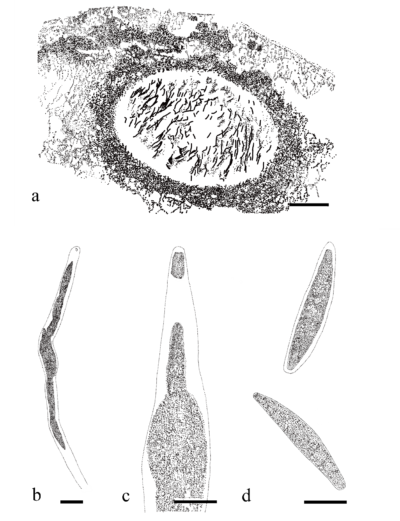Fungalpedia – Note 221, Guestia
Guestia G.J.D. Sm. & K.D. Hyde
Index Fungorum, Facesoffungi, MycoBank, GenBank, Fig. 1
Citation when using this entry: Li et al. 2024 (in prep) – Fungalpedia, Xylariomycetidae.
Classification: Xylariaceae, Xylariales, Xylariomycetidae, Sordariomycetes, Pezizomycotina, Ascomycota, Fungi
Guestia was introduced by Smith & Hyde (2001) in Xylariaceae based on morphology with G. gonetropospora as the type species. This genus consists with only one species (Species Fungorum 2024), which has been reported as saprobe collected from dead rachis of Mauritia flexuosa (palm) in Ecuador. Guestia is characterized by pseudostromata with 1–4 ascomata, black, conical, or hemispherical stromata, with a thin and patchy, 8-spored, unitunicate asci with amyloid apical rings, inequilateral ascospores, and dark germ slit (Smith & Hyde 2001). Wendt et al. (2018) accepted Guestia within the Xylariales genera incertae sedis based on only known morphological descriptions of the conidial states and this taxonomic placement confirmed by Hyde et al. (2020) and Wijayawardene et al. (2020, 2022). No DNA sequence data are available for the type species in NCBI (https://www.ncbi.nlm.nih.gov/; accessed on February 2024).
Type species: Guestia gonetropospora G.J.D. Sm. & K.D. Hyde
Figure 1 – Guestia gonetropospora. a Section of stroma. b, c Asci. d Ascospores. Scale bars: a = 100 μm, b–d = 10 μm. Redrawn from Smith & Hyde (2001).
References
Smith GJD, Hyde KD. 2001 – Fungi from palms. XLIX. Astrocystis, Biscogniauxia,
Entry by
Yanxia Li and Mingkwan Doilom, Innovative Institute for Plant Health/ Key Laboratory of Green Prevention and Control on Fruits and Vegetables in South China, Ministry of Agriculture and Rural Affairs, Zhongkai University of Agriculture and Engineering, Guangzhou, 510225, China.
(Edited by Kevin D Hyde, Mingkwan Doilom, Samaneh Chaharmiri-Dokhaharani, & Achala R. Rathnayaka)
Published online 1 April 2024
